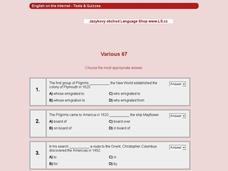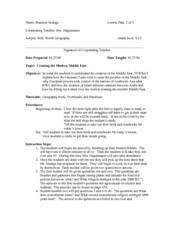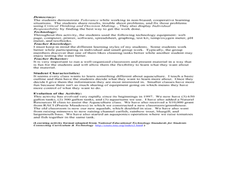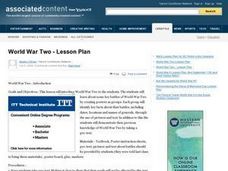Curated OER
The Three Branches of Government
Sixth graders discover details about the 3 branches of government. In this primary source analysis instructional activity, 6th graders examine documents and images from the Library of Congress to investigate the structure of the U.S....
Curated OER
Sectionalism
Learners examine sectionalism. In this sectionalism lesson, students explore reasons sectionalism developed. Learners realize the conflicts that led to the Civil War and how sectionalism affected citizens on the border of Kansas and...
Curated OER
President Obama's Address to Students Across America
Students write about goals, responsibility, and persistence, and listen to President Obama's speech. In this President Obama lesson students create concept webs, listen with a purpose, and list the challenges of our generation.
Curated OER
It's A Free Country, Isn't It?
Students examine immigration into the United States. They identify the rights and responsbilities of being a citizen of this country. They create a new verse to be included in the National Anthem.
Curated OER
GAURI AND PRITHVI: THE SUB-CONTINENT GOES NUCLEAR
Students write short papers on the background of the Pakistani missile called Gauri, named for one of the first Afghan military invaders of India in 11th century, Prithvi is named for Hindu general who fought Muslim invaders, Agni (Hindu...
Curated OER
Lincoln: The Constitution & the Civil War
Students examine the presidency of Abraham Lincoln. In this Abraham Lincoln lesson plan, students analyze the political and constitutional issues that Lincoln dealt with during his time in the White House as they play an online game and...
Curated OER
Who Said That? Scavenger Hunt
In this Presidents worksheet, students explore the Internet to access a specific website to match up five memorable quotes to five memorable Presidents.
Curated OER
American Focus on World Constitutions
Students describe demographic, economic, political and geographic features of the U.S., summarize events leading to the creation of the Constitution and describe the process of amending the Constitution.
Curated OER
The Star-Spangled Banner
Second graders explore American song. In this Star Spangled Banner lesson, 2nd graders discuss what it means the meaning the lyrics of the song and the history behind the song as they participate in a classroom activity.
Curated OER
General Knowledge of American History #67
In this general knowledge of American history #67 worksheet, 6th graders interactively answer 10 multiple choice questions with immediate online feedback.
Curated OER
Examining the Declaration of Independence
Students examine the Declaration of Independence and its significance to American history. They read the document, identify America's grievances with Great Britain, and restate a part of the document in their own words.
Curated OER
What Happened to Slaves When their Owners Died?
Young scholars analyze last and testaments of former slaveowners to identify and explain economic, social and cultural differences between the North and the South leading up to the Civil War.
Curated OER
Unionism versus Secessionism in Virginia
Eleventh graders, in groups, analyze newspaper articles and then debate and discuss if Virginia should succeed from the Union or not.
Curated OER
Supreme Court in Our Lives: Key Cases
Students analyze Supreme Court decisions and their effect on students. They discuss current events realted to the U.S. Constitution and review cases that impact students. They identify each case with its facts, issues, and arguments.
Curated OER
How Acid Rain is Measured and Monitored in the U.S.
Explain how acid rain is measured. They discover how acid rain is monitored in the United States. They compare locally measured pH or rain with that of Great Smoky mountains. They perform Ph tests on rainfall they collect.
Curated OER
Creating the Modern Middle East
Students examine the creation of the Middle East and how the Ottoman Turks attempted to unite the peoples of the Middle East. They discuss why European powers took control of the nations in southwest Asia and how the creation of Israel...
Curated OER
Aquaculture Production in the Classroom
Young scholars study the basics of aquaculture and how to successfully raise aquatic plants and animals. In this water lesson students perform water quality tests on fish tanks, record and graph their results.
Curated OER
The Use of Biocards for Topical Review
Young scholars create biocards to represent vocabulary from their biology course. They review and reinforce their basic knowledge of terminology, structures, or concepts. They create the cards to test themselves or classmates.
Curated OER
A PRICELESS Collection
Students read a story about the life of Russian plant breeder Nikolai I and Vavilov and the national seed bank he established. They research the Irish Potato Famine of the late 1840s and identify the cause for this famine and make...
Curated OER
Math: Heads or Tails
Seventh graders discover the difference between theoretical and experimental probabilities by designing their own problems and testing them. After conducting their own coin toss trial, they compare their results with an Internet...
Curated OER
Personal Indentification For Travel
Young scholars identify and describe the various documents they will need when traveling in the United Stans. They complete forms needed to acquire documentation needed for travel. Students write a description of a travel experience...
Curated OER
World War II
Students create a Powerpoint presentation covering key information regarding a World War II battle and present the information to the class in the form of an oral presentation. They then will turn in a summary report including two...
Curated OER
Review
Eighth graders review and assess their knowledge on the big picture of exploration and the origins of early America. They piece together all the pieces of the puzzle from the past two weeks of study on trade, technology, exploration and...
Curated OER
Memorandum of a Conference with President Eisenhower after Sputnik
Learners use the National Archives to research how the United States and the Soviet Union south to maintain its supremacy after World War II.

























